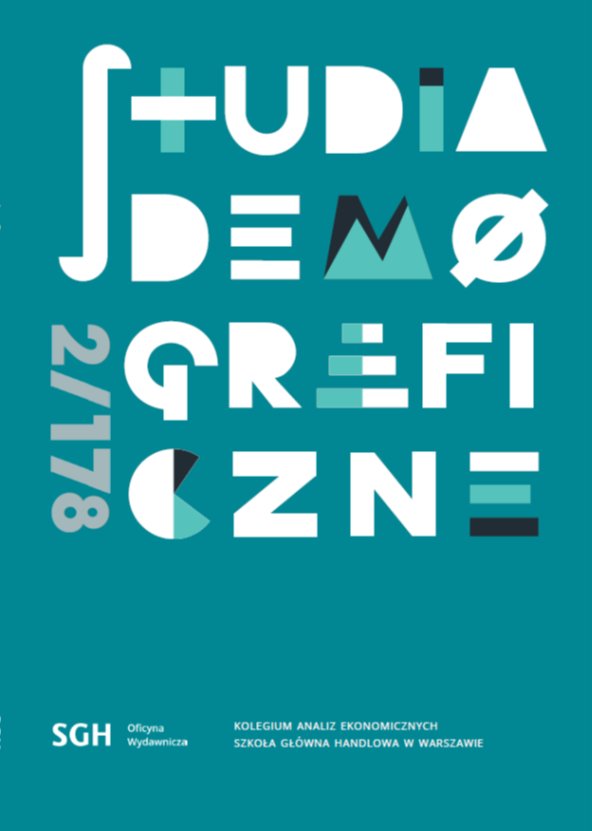Investigating multiple-cause mortality in Poland
Main Article Content
Abstract
Progress in life expectancy and the growing number of people living to old age intensify the phenomenon of multi-morbidity, defined as the coexistence of several chronic diseases. By exploiting all the medical information in death certificates, the multiple causes of death (MCoD) approach serves to investigate complex pathological processes that lead eventually to death. This is the first MCoD analysis for Poland and its objective is twofold: to examine the quality of information on contributing causes of death, in particular in the regional dimension, and to assess the scale of multi-morbidity involving conditions that are becoming more and more frequent in ageing populations. The analysis is carried out for all deaths that took place in Poland in 2013. The results show that medical doctors issuing death certificates often define contributing causes of death, but a large part of this information includes unknown or ill-defined conditions. Several conditions favour the certification of well-defined contributing causes: when death occurs in hospital, or is due to underlying causes other than cardiovascular, the number of contributing conditions is higher. Important regional differences are observed in this regard. The analysis highlights the importance of diseases that are rarely certified as the underlying causes, but often contribute to mortal conditions, such as diseases of the blood and the blood-forming organs, diseases of the skin and subcutaneous tissue, diseases of the genitourinary system or mental and behavioural disorders.
Article Details
References
Anderson, R. (2011). Coding and Classifying Causes of Death: Trends and International Differences. In: R. Rogers, E. Crimmins (Eds.), International Handbook of Adult Mortality (Vol. 2, pp. 467–489). Dordrecht, Netherlands: Springer.
Chamblee, R. F., & Evans, M. C. (1982). New dimensions in cause of death statistics. American Journal of Public Health, 72 (11), 1265–1270.
Cierniak, M. (2014). Na co umarł pacjent—Czyli co jest wpisywane na kartach zgonu? Główny Urząd Statystyczny. Retrieved from: http://stat.gov.pl/obszary-tematyczne/ludnosc/statystyka-przyczyn-zgonow/na-co-umarl-pacjent-czyli-co-jest-wpisywane-na-kartach-zgonow-,1,1.html (accessed: June 30, 2020).
Désesquelles, A., Salvatore, M. A., Frova, L., Pace, M., Pappagallo, M., Meslé, F., & Egidi, V. (2010). Revisiting the mortality of France and Italy with the multiple-cause-of-death approach. Demographic Research, 23, 771–806, https://doi.org/10.4054/Dem-Res.2010.23.28
Dorn, H. F., & Moriyama, I. M. (1964). Uses and significance of multiple cause tabulations for mortality statistics. American Journal of Public Health, 54, 400–406.
Egidi, V., Salvatore, M. A., Rivellini, G., & D’Angelo, S. (2018). A network approach to studying cause-of-death interrelations. Demographic Research, 38, 373–400, https://doi.org/10.4054/DemRes.2018.38.16
Fihel, A. (2011). Umieralność według pojedynczych przyczyn zgonu: Rekonstrukcja danych dla Polski, 1970–2009. Studia Demograficzne, 2, 3–31.
Fihel, A., & Meslé, F. (2016). Cardiovascular diseases as causes of death: Towards coherence and comparability. The 2016 European Population Conference, Mainz.
Fihel, A., Muszyńska, M., & Wróblewska, W. (2014). Umieralność z przyczyn nieznanych i niedokładnie określonych oraz jej trwałe zróżnicowanie terytorialne w Polsce. Studia Demograficzne, 165 (1), 83–102.
GUS (2007). Final report within Project No 14, Improvement of statistics of causes of death. GUS.
Israel, R. A., Rosenberg, H. M., & Curtin, L. R. (1986). Analytical Potential for Multiple Cause-of-Death Data. American Journal of Epidemiology, 124 (2), 161–179.
Janssen, T. A. (1940). Importance of tabulating multiple causes of death. American Journal of Public Health, 30 (8), 871–879. [13] Jędrychowski, W., Mróz, E., Wiernikowski, A., & Flak, E. (2001). Trafność wyboru przez lekarza wyjściowej przyczyny zgonu i kodowania danych z kart zgonów. Przegląd Epidemiologiczny, 55 (3), 313–322.
Manton, K. G., & Stallard, E. (1982). Temporal trends in U. S. multiple cause of death mortality data: 1968 to 1977. Demography, 19 (4), 527–547.
Marengoni, A., Angleman, S., Melis, R., Mangialasche, F., Karp, A., Garmen, A., Meinow, B., & Fratiglioni, L. (2011). Aging with multimorbidity: A systematic review of the literature. Ageing Research Reviews, 10 (4), 430–439, https://doi.org/10.1016/j.arr.2011.03.003
Mathers, C., Fat, D. M., Inoue, M., Rao, C., & Lopez, A. D. (2005). Counting the dead and what they died from: An assessment of the global status of cause of death data. Bulletin of the World Health Organization, 83 (3), 171–180.
Murray, C., & Lopez, A. D. (1996). The global burden of disease: A comprehensive assessment of mortality and disability from diseases, injuries, and risk factors in 1990 and projected to 2020. Harvard University Press.
Pechholdová, M. (2014). Multiple Cause-of-Death Data in the Czech Republic: An Exploratory Analysis. Demografie, 56, 335–346.
Stawińska-Witoszyńska, B., Gałęcki, J., Wasilewski, W., & Narodowy Program Zdrowia. (2019). Poradnik szkoleniowy dla lekarzy orzekających o przyczynach zgonów i wystawiających kartę zgonu. PZH – Narodowy Instytut Zdrowia Publicznego.
Susło, R. (2011). Dokumentacja medyczna – uciążliwość czy ostatnia deska ratunku? Konferencja „Prawo a Medycyna” we Wrocławiu, Wrocław. Retrieved from: http://www.prawoamedycyna.interpolska.pl/assets/Uploads/Prezentacje/Robert-Suslo-Dokumentacja-medyczna.pdf (accessed: June 30, 2020).
Wasilewski, W., Wasilewska, W., Bartnikowska, O., & Elias, M. (2013). Analiza porównawcza kodowania przyczyn zgonów oprogramowaniem IRIS i metodą manualną. Urząd Statystyczny w Olsztynie.
White, M. C., Selvin, S., & Merrill, D. W. (1989). A study of multiple causes of death in California: 1955 and 1980. Journal of Clinical Epidemiology, 42 (4), 355–365, https://doi.org/10.1016/0895–4356 (89) 90040–1
WHO (1967). Manual of the International Statistical Classification of Diseases, Injuries and Causes of Death. WHO.
WHO (2008). International Statistical Classification of Diseases and Related Health Problems. Tenth Revision (Vol. 2). WHO.
WHO (2011). ICD-10: International statistical classification of diseases and related health problems. WHO.
Wing, S., & Manton, K. G. (1981). A multiple cause of death analysis of hypertension-related mortality in North Carolina, 1968–1977. American Journal of Public Health, 71 (8), 823–830.
Wojtyniak, B., Jankowski, K., Zdrojewski, T., & Opolski, G. (2012). Regional differences in determining cardiovascular diseases as the cause of death in Poland: Time for change. Kardiologia Polska, 70 (7), 695–701.
Wojtyniak, B., Rabczenko, D., Pokarowski, P., Poznańska, A., & Stokwiszewski, J. (2012). Atlas umieralności ludności Polski w latach 1999–2001 i 2008–2010. Retrieved from: www.atlas.pzh.gov.pl (accessed: June 30, 2020).
